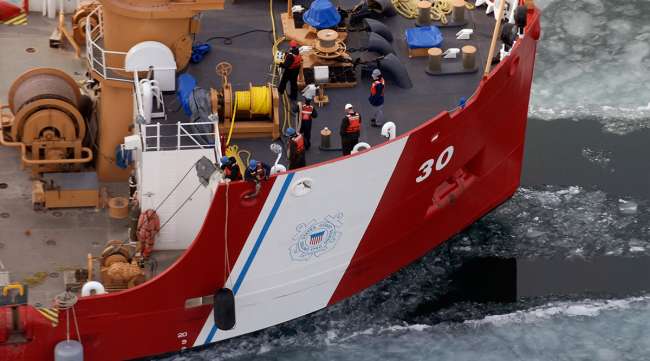The Detroit News
Congress OKs $350M for Great Lakes Icebreaker

[Stay on top of transportation news: Get TTNews in your inbox.]
Congress has authorized funding for a new icebreaker for the Great Lakes, a priority that the shipping industry and Sen. Gary Peters (D-Mich.) have sought for years to fight ice dams in the lakes and surrounding waterways.
The money is from the $1.7 trillion budget bill that President Joe Biden signed into law Dec. 29. The bill provides an authorization of $350 million to acquire an additional Great Lakes heavy icebreaker.
The Coast Guard did not respond to questions on when it will be able to buy a heavy icebreaker and deploy it.
“This is a big win for the 4th Sea Coast,” Great Lakes Maritime Task Force President Jim Weakley said in a statement, referring to a nickname for the Great Lakes. “Finally, there is recognition that the USCG is not adequately resourced to facilitate critical winter navigation on the Great Lakes. The North American economy and our national security are dependent on the raw materials, like iron ore, that need to move effectively to maintain the nation’s steel production.”
Weakley is also president of the Lake Carriers’ Association, which represents the Great Lakes shipping industry.
The Coast Guard has one heavy icebreaker on the Great Lakes — the Mackinaw, a 240-foot vessel that has the capacity to break through heavy ice that typically forms in the Straits of Mackinac between Lakes Michigan and Huron. It also has six smaller, 140-foot cutters stationed around the Great Lakes, all built between 1979 and 1988, and two buoy tenders that have some icebreaking capacity.
But icebreakers are often laid up for maintenance, Coast Guard Ninth District ice supervisor Brian Smicklas told The Detroit News in 2021.
The Mackinaw was sidelined for maintenance at least twice last winter.

Hosts Seth Clevenger and Mike Freeze mark 100 episodes of RoadSigns, which started off four years ago asking, "Autonomous: Who's Behind the Wheel of Tomorrow?" Now, see where trucking was in 2018 and where it's going in 2023. Hear a snippet, above, and get the full program by going to RoadSigns.TTNews.com.
The heavy icebreaker wasn’t available in early January 2022 when St. Clair County’s shoreline flooded, so one of the Canadian Coast Guard’s cutters was the only ship available to respond.
The icebreakers not only help to alleviate ice jams that cause flooding along inland communities but help maintain dependable shipping routes to move goods and materials through the Great Lakes year-round. The lack of adequate icebreakers in the past decade has cost an estimated $2 billion, the Great Lakes Maritime Task Force said in its news release.
In addition to the icebreaker, Congress also authorized the Government Accountability Office to study the effectiveness on the Coast Guard’s icebreaking mission as well as what resources are needed to improve the supply chain that travels via boat in the winter. Since polar vortexes are expected to become more frequent, ice jam flooding in the region has become more extreme, the task force said.
The Lake Carriers’ Association has argued the GAO study could help better determine the appropriate size of the Great Lakes fleet. The industry group has questioned the Coast Guard’s performance recordkeeping, which only measures their availability to break ice in nine specific waterways, including the Detroit and St. Clair rivers.
“So if Lake Huron’s frozen, if Lake Erie’s frozen, none of that counts,” said Eric Peace of the Lake Carriers’ Association. “You could be stuck there for weeks, and it would never be reported to Congress.”
The Coast Guard measures icebreaking in Tier 1 and Tier 2 waterways. Tier 1, which in the Great Lakes includes the Detroit, St. Clair and St. Mary’s rivers, the Straits of Mackinac and other passages, are “the most used and important” because they connect the separate Great Lakes, according to the Coast Guard’s Smicklas.
Tier 2 waterways, which include bays like Green Bay, Saginaw Bay, Maumee Bay and portions of the larger lakes, connect Tier 1 waterways and federally maintained waterways that lead into a port.
Want more news? Listen to today's daily briefing below or go here for more info:
Distributed by Tribune Content Agency, LLC




